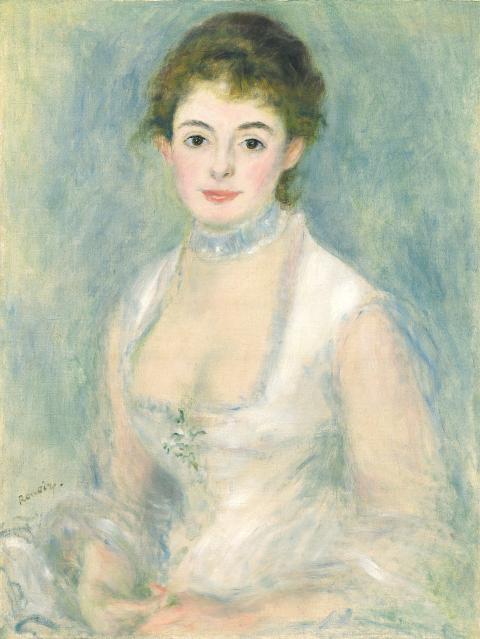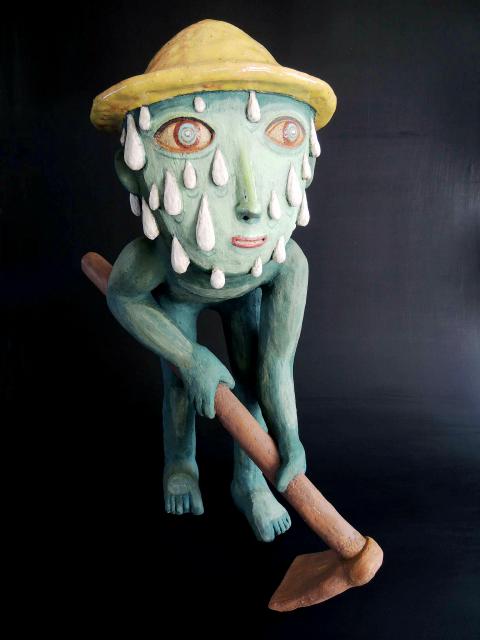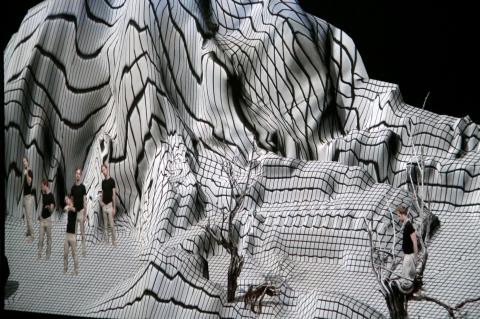Peter Nelson brings video animation to Ming Dynasty scrolls at the Peter Nelson Solo Exhibition. In Extensions of a No-Place (Wen Zheng-ming), he shows a tiny digital man in a Wen Zheng-ming (文徵明) landscape painting, which is displayed across five separate screens and updated with Taipei’s architectural motifs. In another video work, Extensions of a No-Place (Qiu Ying), Nelson plays up the curiosities in Qiu Ying’s (仇英) painting of palace ladies, such as the spatial logic’s close relationship to Starcraft and the courtesan’s gender performativity in a cosmopolitan environment. These animations are the latest additions to Extensions of a No-Place, Nelson’s ongoing series of sculptures, sketches and video that make up an imaginary world.
■ Barry Room, Taipei Artist Village (台北國際藝術村百里廳), 7 Beiping E Rd, Taipei City (台北市北平東路7號), tel: (02) 3393-7377. Open Tuesdays to Sundays from 11am to 9pm
■ Until June 16

Photo courtesy of the National Palace Museum
Ordinary Household (尋常人家) results from an interactive approach: Photographer Chen Chin-pao (陳敬寶) visited the homes of volunteers and asked what they did in their homes most often, what they wanted to do the most and what domestic event they would always remember. Subjects are photographed acting out their answers in the most familiar environment they know. Chen is best known for projects that hone in on the quotidian, including Betel Nut Girls, Circumgyration and Heaven on Earth, which was awarded the Higashikawa Award in 2011.
■ 1839 Contemporary Gallery (當代藝廊), B1, 120 Yanji St, Taipei City (台北市延吉街120號B1), tel: (02) 2778-8458. Open Tuesdays to Sundays from 11am to 8pm. Free admission
■ Until June 30

Photo courtesy of Sing Art Gallery
From Mountains to the Sea: Taiwan Landscape (山海之間) opens tomorrow at Art Den (藝研齋), featuring oil paintings, watercolor and silkscreens of Taiwan landscapes by two artists. Chen Min-tse (陳敏澤) treats lavender fields and autumnal lakesides with her usual theatrical visual language, while May Chao (趙梅) minimizes lines and strokes, stripping the land of its darker features and making it appear light and simple, if only for a moment.
■ Art Den (藝研齋), 3F, 309 Xinyi Rd Sec 4, Taipei City (台北市信義路四段309號3樓), tel: (02) 2325-8188. Open Tuesdays to Saturday from 10:30am to 6:30pm
■ Opens tomorrow. Until June 6

Photo courtesy of Sing Art Gallery
Renoir and Painters of the Twentieth Century is Taiwan’s first major exhibition themed on Pierre-Auguste Renoir. The National Palace Museum (NPM, 國立故宮博物院) brings together 65 works by Renoir and the artists he influenced, including Pablo Picasso, Henri-Emile-Benoit Matisse, Pierre Bonnard and Raoul Dufy. Paintings are sourced from eleven museums in Japan, the US and France, and divided into six themes: ladies in hats; flowers; women; gardens and music; representations of the body; and southern France and the Mediterranean.
■ Library Building, National Palace Museum (國立故宮博物院圖書文獻大樓), 221 Zhishan Rd Sec 2, Taipei City (台北市至善路二段221號), tel: (02) 2881-2021. Open daily from 9am to 5pm
■ Until Sept. 8

Photo courtesy of the Taipei Artist Village
A Countryside Record (田園紀事) is a sweetly impish interpretation of agrarian society by Chang Ho-min (張和民), a sculptor who works mostly with ceramics. Chang’s statuettes are farmers with absurd add-ons: one is riding a giant millipede, and another tills the soil as jumbo pearls of sweat stream from his brow.
■ Sing Art Gallery (新心藝術館), 67 Shengli Rd, Greater Tainan (台南市勝利路67號), tel: (06) 275-3957. Open Tuesdays to Sundays from noon to 8pm; closed Mondays and the second and fourth Sunday of every month
■ Opens tomorrow. Until June 30

The canonical shot of an East Asian city is a night skyline studded with towering apartment and office buildings, bright with neon and plastic signage, a landscape of energy and modernity. Another classic image is the same city seen from above, in which identical apartment towers march across the city, spilling out over nearby geography, like stylized soldiers colonizing new territory in a board game. Densely populated dynamic conurbations of money, technological innovation and convenience, it is hard to see the cities of East Asia as what they truly are: necropolises. Why is this? The East Asian development model, with

June 16 to June 22 The following flyer appeared on the streets of Hsinchu on June 12, 1895: “Taipei has already fallen to the Japanese barbarians, who have brought great misery to our land and people. We heard that the Japanese occupiers will tax our gardens, our houses, our bodies, and even our chickens, dogs, cows and pigs. They wear their hair wild, carve their teeth, tattoo their foreheads, wear strange clothes and speak a strange language. How can we be ruled by such people?” Posted by civilian militia leader Wu Tang-hsing (吳湯興), it was a call to arms to retake

This is a deeply unsettling period in Taiwan. Uncertainties are everywhere while everyone waits for a small army of other shoes to drop on nearly every front. During challenging times, interesting political changes can happen, yet all three major political parties are beset with scandals, strife and self-inflicted wounds. As the ruling party, the Democratic Progressive Party (DPP) is held accountable for not only the challenges to the party, but also the nation. Taiwan is geopolitically and economically under threat. Domestically, the administration is under siege by the opposition-controlled legislature and growing discontent with what opponents characterize as arrogant, autocratic

When Lisa, 20, laces into her ultra-high heels for her shift at a strip club in Ukraine’s Kharkiv, she knows that aside from dancing, she will have to comfort traumatized soldiers. Since Russia’s 2022 invasion, exhausted troops are the main clientele of the Flash Dancers club in the center of the northeastern city, just 20 kilometers from Russian forces. For some customers, it provides an “escape” from the war, said Valerya Zavatska — a 25-year-old law graduate who runs the club with her mother, an ex-dancer. But many are not there just for the show. They “want to talk about what hurts,” she